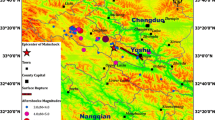Abstract
The increasing interest in seismic risk assessment in Morocco is due to the growing frequency of earthquakes, such as the one in Al Haouz in 2023, and the rapid population expansion in these areas. This study focuses on regions with moderate to high seismic activity to better understand the seismic risk in these areas. A critical aspect of this assessment is establishing damage (or fragility) curves, which are necessary for assessing damage levels and making decisions regarding the renovation or demolition of structures. However, a shortfall in seismic regulations is the constant behavior factor, regardless of seismicity level (zones 3, 4, and 5) or structure height. Moroccan seismic regulations (RPS2000) and international standards generally advocate for a fixed value of the behavior factor but often neglect crucial parameters such as structure height and local seismic intensity.












Similar content being viewed by others
Data availability
No datasets were generated or analysed during the current study.
References
Cherkaoui TE, Hatzfeld D, Jebli H, Medinan F, Caillot V (1990) Etude microsismique de la région d’Al Hoceima. Bull Inct Sci Rabat 12:25–34
D’Ayala D, Speranza E (2003) Definition of collapse mechanisms and seismic vulnerability of historic masonry buildings. Earthq Spectra 19(3):479–509. https://doi.org/10.1193/1.1599896
Yeck WL, Hatem AE, Goldberg DE, Barnhart WD, Jobe JAT, Shelly DR, Villaseñor A, Benz HM, Earle PS (2023) Rapid source characterization of the 2023 Mw 6.8 Al Haouz, Morocco. Earthquake Seism Rec 3:357–366. https://doi.org/10.1785/0320230040
Buforn E, Galdeano CSD, Udias A (2004) Seismotectonics of the Ibero-Maghrebian region. Tectonophysics 30(248):247–261
RPS. Règlement de Construction Parasismique. Ministère de l’Aménagement du Territoire, de l’Urbanisme, de l’Habitat et de l’Environ-nement; Secrétariat d’Etat à l’Habitat, Rabat, Morocco 17
RPS (2000) Règlement de Construction Parasismique, Version 2011, Ministère de l’Habitat, de l’Urbanisme et de l’Aménagement de l’Es-pace, Rabat, Morocco
Kassem MM, Mohamed Nazri F, Noroozinejad Farsangi E (2020) The seismic vulnerability assessment methodologies: a state-of-the-art review. Ain Shams Eng J 11:849–864. https://doi.org/10.1016/j.asej.2020.04.001
Applied Technology Council, ATC-40 (1996) Seismic evaluation and retrofit of concrete buildings, California 1 and 2
Kim S, D’Amore E (1999) Pushover analysis procedure in earthquake engineering. EarthqSpectra 15:417–423. https://doi.org/10.1193/1.1586051
Ziraoui A, Kissi B, Aaya H, Azdine I (2023) Techno-economic study of seismic vulnerability in reinforced concrete structures by composite materials. Int Rev Civ Eng IRECE 14:561. https://doi.org/10.15866/irece.v14i6.22940
Ziraoui A, Kissi B, Aaya H, Mezriahi Y, Haimoud A (2023) Seismic retrofitting: analyzing the effectiveness of RC shear walls and CFRP reinforcement for RC structures. pp 203–214. https://doi.org/10.1007/978-3-031-49345-4_21
Elnashai AS (2001) Advanced inelastic (pushover) analysis for earthquake applications. Struct Eng Mech 12:51–6. https://doi.org/10.12989/sem.2001.12.1.051
Newmark NM, Hall WJ (1982) Earthquake spectra and design. EERI Monograph Series, EERI, Okland, CA, USA
Krawinkler H, Nassar AA (1992) Seismic design based on ductility and cumulative damage demand and capacities. In: Fajfar P, Krawinkler H (eds) Nonlinear seismic analysis and design of reinforced concrete buildings. Elsevier apllied science, New York
Fajfar P (2002) Structural analysis in earthquake engineering a breakthrough of simplified nonlinear methods. 12th European conference on earthquake engineering
Mander JB, Priestley MJN (1988) Observed stress-strain behavior of confined concrete. J Struct Eng ASCE 114(8):1827–1849
Shome N, Cornell CA (1999) Probabilistic seismic demand analysis of nonlinear structures.Tech. Rep. RMS–35, RMS Program, Stanford University, CA
FEMA (1999) “HAZUS Earthquake loss estimation methodology”, Federal emergency management agency, Washington, D.C.
BAEL 91. Règles techniques de conception et de calcul des ouvrages et constructions en Béton Armé suivant la Méthode des Etats limites. Edition Eyrolles: 1992, Paris, France. ISBN: 221210023X
Tbatou T, El Youbi M (2020) Dynamic and structural study of a RC building braced by FRP composite materials. Int Rev Civil Eng 11(1):1–9. https://doi.org/10.15866/irece.v11i1.16991
Ziraoui A, Kissi B, Aaya H (2024) Probabilistic analysis of FRP efficacy in seismic risk reduction. Forces Mech 100259. https://doi.org/10.1016/j.finmec.2024.100259
(2005) CSI Analysis Refrence Manual for SAP2000, ETABS, and SAFE – computers and structures, Inc.Berkeley, California, USA
Funding
The authors declare that no funds, grants, or other support were received during the preparation of this manuscript.
Author information
Authors and Affiliations
Contributions
Adil Ziraoui: Methodology, Investigation, Resources, Writing– original draft, Writing – review & editing. Benaissa Kissi: Conceptualization, Formal analysis, Writing – original draft, Writing – review & editing. Hassan Aaya: Validation, Formal analysis, Writing – original draft, Visualization. Najoua Mrabet: Conceptualization, Formal analysis, Writing – original draft, Writing – review & editing. Ilhame Azdine: Conceptualization, Software, Validation, Resources, Writing – original draft, Supervision.
Corresponding author
Ethics declarations
Competing interests
The authors declare no competing interests.
Additional information
Publisher's Note
Springer Nature remains neutral with regard to jurisdictional claims in published maps and institutional affiliations.
Rights and permissions
Springer Nature or its licensor (e.g. a society or other partner) holds exclusive rights to this article under a publishing agreement with the author(s) or other rightsholder(s); author self-archiving of the accepted manuscript version of this article is solely governed by the terms of such publishing agreement and applicable law.
About this article
Cite this article
Ziraoui, A., Kissi, B., Aaya, H. et al. Seismic risk assessment, damage estimation, and strengthening of seismic construction standards in Morocco. J Build Rehabil 9, 79 (2024). https://doi.org/10.1007/s41024-024-00437-z
Received:
Revised:
Accepted:
Published:
DOI: https://doi.org/10.1007/s41024-024-00437-z




